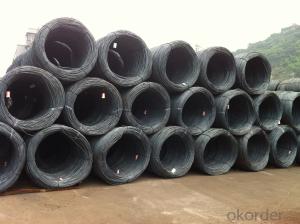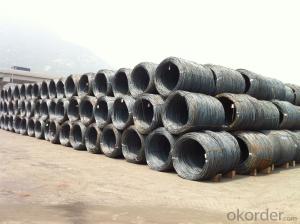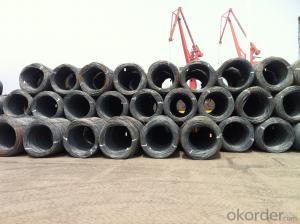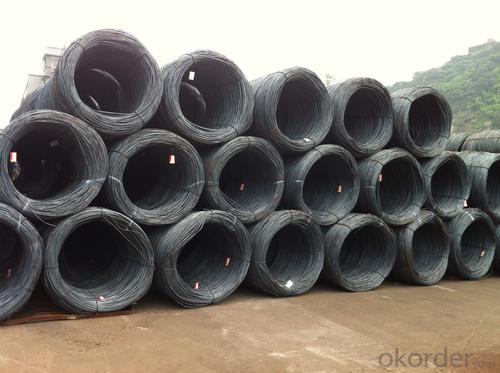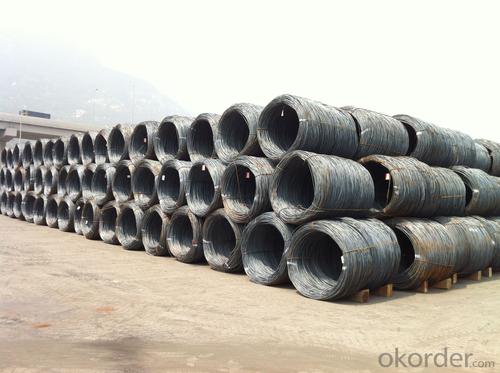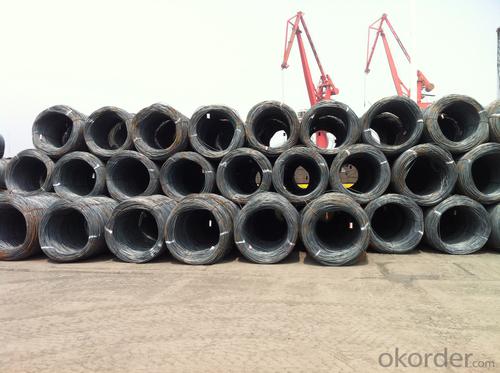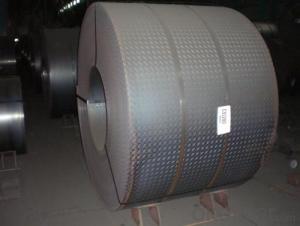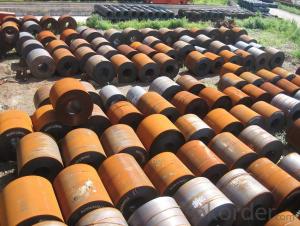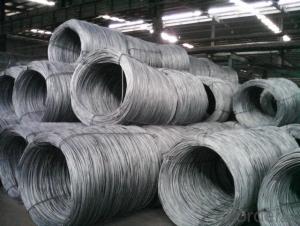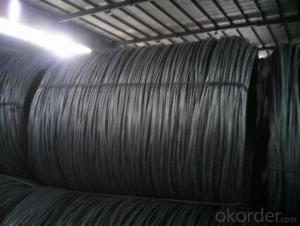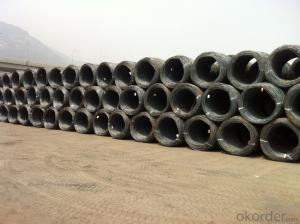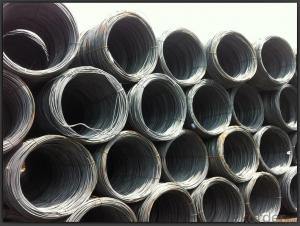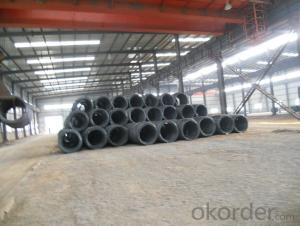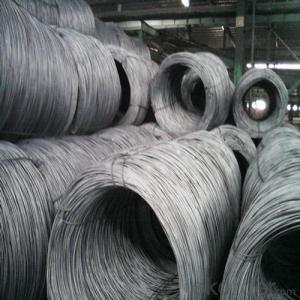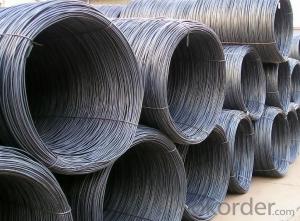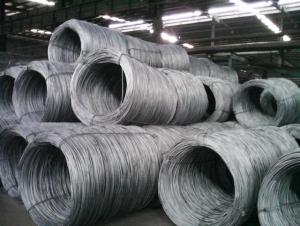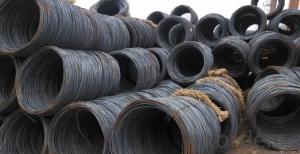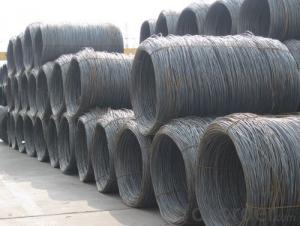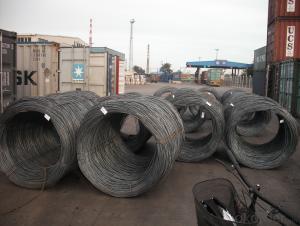Hot Rolled Steel Wire rods in Grade SAE1008B
- Loading Port:
- Tianjin
- Payment Terms:
- TT OR LC
- Min Order Qty:
- 25 m.t
- Supply Capability:
- 10000 m.t/month
OKorder Service Pledge
OKorder Financial Service
You Might Also Like
OKorder is offering Carbon Steel Wire Rod at great prices with worldwide shipping. Our supplier is a world-class manufacturer of steel, with our products utilized the world over. OKorder annually supplies products to European, North American and Asian markets. We provide quotations within 24 hours of receiving an inquiry and guarantee competitive prices.
Product Applications:
Carbon Steel Wire Rod are ideal for structural applications and are widely used in the construction of buildings and bridges, and the manufacturing, petrochemical, and transportation industries.After hot-rolled the products shaped into coil and delivery as finished product, including round, square, rectangular, hexagonal and so on. Since most of the products are round, it is generally called wire rod. Carbon steel wire rod is widely used in construction and manufacturing. Carbon steel wire rod is mainly used for reinforcement of reinforced concrete and welded structure or reprocessed (roberts , nail, etc.) materials, especially used to produce wire drawing, welding electrode, nails, spring, electronic, precise machinery parts and so on.
Product Advantages:
OKorder's Carbon Steel Wire Rod are durable, strong, and resist corrosion.
Main Product Features:
· Premium quality
· Prompt delivery & seaworthy packing (30 days after receiving deposit)
· Corrosion resistance
· Can be recycled and reused
· Mill test certification
· Professional Service
· Competitive pricing
Product Specifications:
Chemical Composition:
Please kindly find our chemistry of our material based on SAE1006/SAE1008 as below for your information
Grade | Chemical Composition (%) | |||||
C | Mn | S | P | Si | B | |
SAE1006B | 0.03~O.07 | 0.32max | 0.045max | 0.040max | 0.30max | 0.0008min |
Mechanical properties | ||||||
Yield strength(N/mm2) | Tensile strength(N/mm2) | Elongation (%) | ||||
250-280 | 350-380 | ≥32 | ||||
Grade | Chemical Composition (%) | |||||
C | Mn | S | P | Si | B | |
SAE1008B | 0.10max | 0.3~0.50 | 0.050max | 0.040 max | 0.15max | 0.0008 min |
Mechanical properties | ||||||
Yield strength(N/mm2) | Tensile strength(N/mm2) | Elongation (%) | ||||
≥195 | 315-430 | ≥30 | ||||
FAQ:
Q1: Why buy Materials & Equipment from OKorder.com?
A1: All products offered by OKorder.com are carefully selected from China's most reliable manufacturing enterprises. Through its ISO certifications, OKorder.com adheres to the highest standards and a commitment to supply chain safety and customer satisfaction.
Q2: Can stainless steel rust?
A2: Stainless does not "rust" as you think of regular steel rusting with a red oxide on the surface that flakes off. If you see red rust it is probably due to some iron particles that have contaminated the surface of the stainless steel and it is these iron particles that are rusting. Look at the source of the rusting and see if you can remove it from the surface.
Q3: How soon can we receive the product after purchase?
A3: Within three days of placing an order, we will begin production. The specific shipping date is dependent upon international and government factors, but is typically 7 to 10 workdays.
Image:
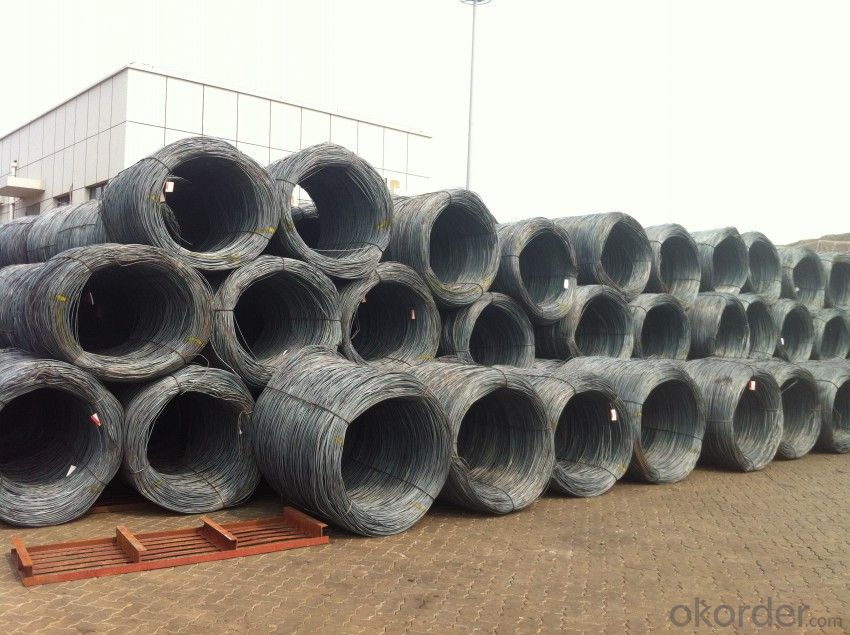

- Q: How is steel wire rod used in the manufacturing of wire bins?
- Steel wire rod is used in the manufacturing of wire bins as it serves as the primary raw material for creating the wire mesh structure of the bins. The steel wire rod is first processed and drawn into the desired diameter and strength, then it is further shaped and welded to form the sturdy and durable framework of the wire bins. This framework provides the necessary strength and support to hold and contain items within the bins, making them suitable for various storage and organization purposes.
- Q: Can steel wire rod be used for welding applications?
- Yes, steel wire rod can be used for welding applications. Steel wire rods are commonly used as a filler material in welding processes. They are typically made from low carbon steel and are available in various sizes and grades to meet specific welding requirements. Steel wire rods can be used for welding applications such as arc welding, MIG welding, TIG welding, and spot welding. They provide a strong and reliable weld when used correctly. However, it is important to select the appropriate wire rod based on the type of metal being welded and the specific welding process being used.
- Q: How is steel wire rod straightened and cut to length?
- Steel wire rod is straightened and cut to length using a combination of mechanical and automated processes. Firstly, the wire rod is passed through a series of straightening rolls that apply pressure to remove any bends or kinks, ensuring a straight and uniform shape. Once straightened, the rod is fed into a cutting machine equipped with circular blades or shears, which precisely cut it to the desired length. This process ensures that steel wire rod is efficiently straightened and cut to meet specific requirements in various industries.
- Q: What are the different types of steel wire rod surface cleaning techniques?
- Various industries employ several different techniques to clean the surface of steel wire rods, removing impurities, rust, scale, or other contaminants. Some commonly used techniques include: 1. Mechanical Cleaning: The surface of steel wire rods is cleaned through mechanical abrasion using wire brushes, steel wool, or abrasive pads. This method effectively removes loose rust, scale, or paint. 2. Chemical Cleaning: Chemicals or solvents are used to dissolve or loosen contaminants on the surface. Acidic or alkaline solutions are typically employed for this purpose. The cleaning solution is applied to the steel wire rods, breaking down impurities, and rinsed off with water to remove residue. 3. Shot Blasting: High-speed steel shots or grits are propelled against the surface of steel wire rods using compressed air or centrifugal force. This technique efficiently removes rust, scale, or contaminants. 4. Pickling: Specifically designed for removing oxide layers, pickling involves immersing the steel wire rods in an acidic solution, usually hydrochloric acid. This dissolves the oxide layers, resulting in a clean and smooth surface. 5. Ultrasonic Cleaning: High-frequency sound waves create tiny bubbles in a cleaning solution, which effectively remove contaminants from the surface of steel wire rods. This technique is commonly used for delicate or intricate parts, with the rods submerged in a tank filled with the cleaning solution and subjected to ultrasonic waves to dislodge impurities. These techniques are commonly employed to clean the surface of steel wire rods, with the choice depending on the specific requirements of the industry and desired level of cleanliness.
- Q: What are the different surface protection materials used for steel wire rod?
- Some common surface protection materials used for steel wire rods include coatings such as zinc, galvanized, or polymer-based coatings. These materials provide a protective layer to prevent corrosion and enhance the durability of the wire rods. Additionally, other surface protection methods such as electroplating or heat treatment may also be utilized in specific applications to enhance the surface properties of the wire rod.
- Q: What are the main factors affecting the machinability of steel wire rod?
- The main factors affecting the machinability of steel wire rod include the composition of the steel, its hardness, the presence of impurities and inclusions, the surface finish of the wire rod, and the cutting tool material and geometry.
- Q: How is steel wire rod used in the production of wire mesh partitions?
- Steel wire rod is used in the production of wire mesh partitions as it serves as the primary material for creating the wire mesh. The steel wire rod is first drawn through a series of dies to reduce its diameter and increase its length. This process creates a thin and flexible wire that can be easily woven or welded together to form the mesh structure of the partition. The wire mesh partitions provide strength, stability, and security, making them ideal for various applications such as dividing spaces, creating secure enclosures, or forming protective barriers.
- Q: What are the different surface coatings used for steel wire rod?
- There are several different surface coatings that can be used for steel wire rods. Some common ones include galvanized coatings, which provide corrosion resistance, and copper coatings, which improve conductivity. Additionally, there are coatings like phosphate coatings that enhance adhesion for subsequent coatings, and polymer-based coatings that offer lubricity and reduce friction. The choice of coating depends on the intended application and specific requirements for the steel wire rod.
- Q: How is steel wire rod used in the production of suspension springs for railway vehicles?
- Steel wire rod is used in the production of suspension springs for railway vehicles as it provides the necessary strength and durability required to withstand the heavy loads and constant vibrations experienced in rail operations. The steel wire rod is first shaped and coiled into the desired spring design, ensuring proper tension and flexibility. These suspension springs are then integrated into the suspension system of railway vehicles, helping to absorb shocks, maintain stability, and provide a smooth and comfortable ride for passengers and cargo.
- Q: How are steel wire rods used in the production of wire ropes for heavy lifting?
- The strength, durability, and versatility of steel wire rods are crucial in the production of wire ropes for heavy lifting. Wire ropes are essential for safe and effective heavy lifting because they offer the required strength and support. To produce wire ropes, steel wire rods are used as the raw material. These rods are typically made of high-quality, high-carbon steel, which possesses excellent tensile strength and resistance to wear and tear. To ensure the longevity and reliability of the wire ropes, the rods are first cleaned and coated to prevent corrosion. The manufacturing process begins by drawing the wire rods through a series of dies. This reduces their diameter and increases their length, thereby increasing their tensile strength. The drawn wires are then twisted together in a specific pattern to form strands. These strands are further twisted together in a helical pattern around a core, which can be made of hemp, steel, or synthetic materials based on the specific application and load requirements. This forms the final wire rope. The utilization of steel wire rods in wire rope production guarantees that the resulting wire ropes possess the necessary strength and durability for heavy lifting operations. They can endure immense tension and bear heavy loads without deforming or breaking. This is particularly important in industries like construction, mining, and maritime, where heavy lifting operations are common. Additionally, steel wire rods offer excellent resistance to abrasion, corrosion, and fatigue. This makes wire ropes suitable for harsh environments and prolonged use. These properties are crucial for heavy lifting applications, as the wire ropes need to maintain their integrity and reliability even under extreme conditions. In conclusion, steel wire rods play a vital role in the production of wire ropes for heavy lifting. They provide the required strength, durability, and versatility to ensure the safety and efficiency of heavy lifting operations across various industries.
Send your message to us
Hot Rolled Steel Wire rods in Grade SAE1008B
- Loading Port:
- Tianjin
- Payment Terms:
- TT OR LC
- Min Order Qty:
- 25 m.t
- Supply Capability:
- 10000 m.t/month
OKorder Service Pledge
OKorder Financial Service
Similar products
Hot products
Hot Searches
Related keywords
